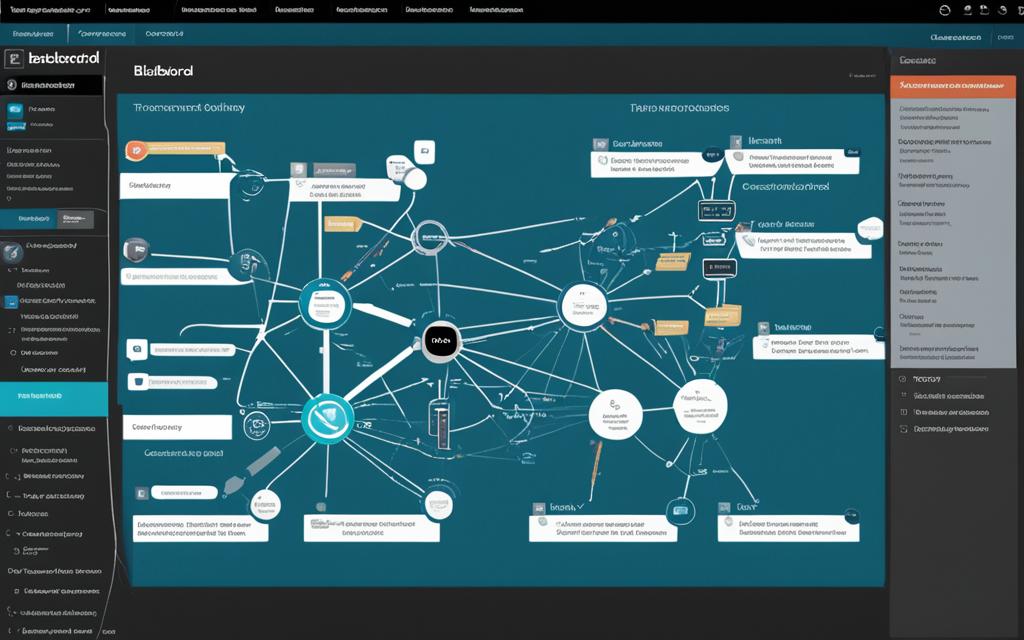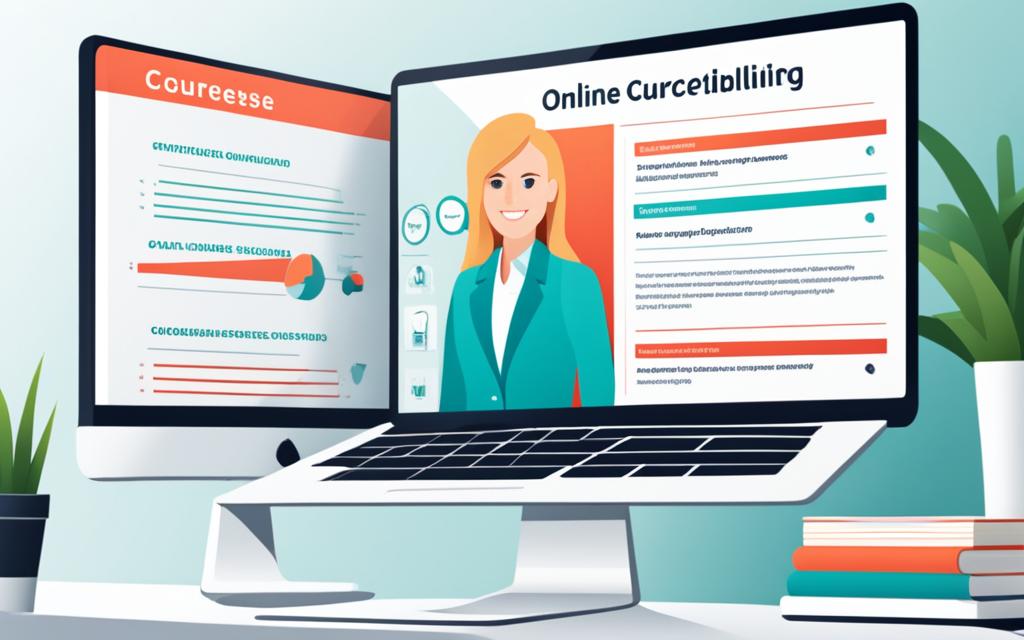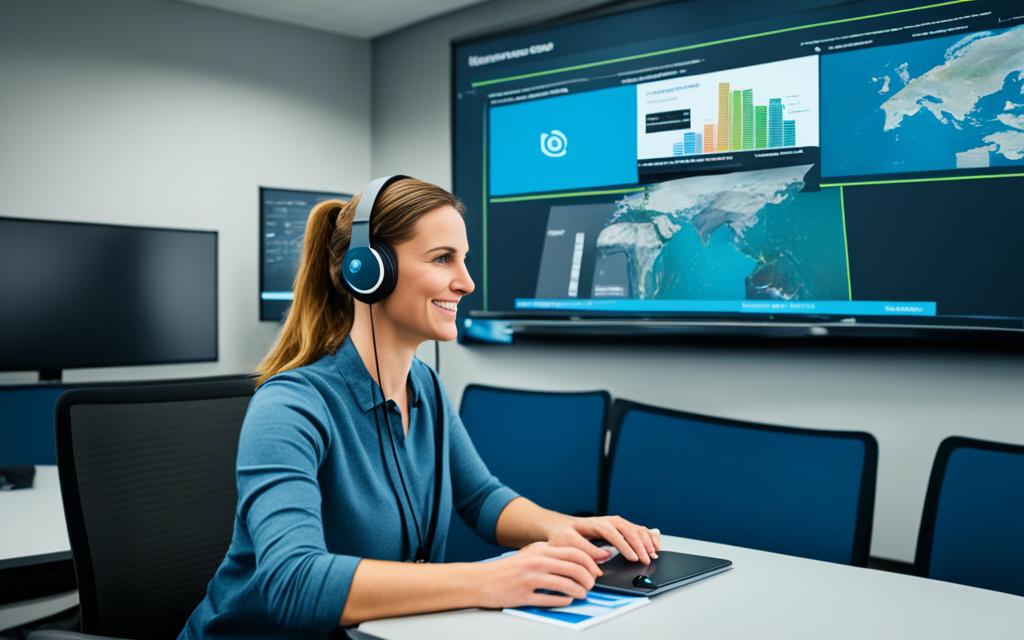In today’s world, EdTech tools play a big role in higher education. They make learning better, handle tasks easier, and engage students more. The use of technology is leading educational innovation. It introduces a new level1 of quality online education. Now, students can enjoy premium courses and learn in an interactive way from their own homes. This article will look at the latest EdTech tools in higher education. It shows how they improve online education to amazing levels.
Key Takeaways
- EdTech tools are transforming higher education, enabling quality online learning experiences.
- Comprehensive learning management systems like Canvas LMS and Blackboard offer robust course delivery and management features.
- Interactive presentation platforms such as ClassPoint are revolutionizing student engagement and formative assessments.
- Virtual classrooms and video conferencing tools are bridging the gap between physical and digital learning spaces.
- Innovative technologies like augmented reality, virtual reality, and artificial intelligence are reshaping the future of online education.
Revolutionizing Higher Education with EdTech Tools
EdTech tools are changing how we learn in college.2 Teachers use these new technologies to make lessons more exciting and personal. They include things like online systems for learning, virtual classrooms, and videos.3 This new way of teaching is making knowledge more accessible and fun to get.4
Using technology in college has many pluses.2 It boosts how interested students are and helps them learn better. It lets students learn at their own pace, getting them ready for the tech future.3 But, to make these tools really work, colleges must plan well. They need to make sure they don’t cause problems and that everyone can use them.2
The COVID-19 pandemic has made new learning tools even more essential.4 With many schools and colleges closed, over 1.5 billion students had to turn to remote learning. Now, over 30% of college students in the U.S. are taking classes online.4
Education is changing fast, thanks to EdTech.4 This tech is key to making learning great for everyone. It turns learning into a personal and fun experience that helps students succeed in today’s tech world.3
Interactive Presentations: ClassPoint Transforms Learning
ClassPoint is changing how we teach and learn in colleges. It is at the forefront of new ideas in teaching with technology. It works hand in hand with PowerPoint, making lessons not just visual but hands-on for students.5 Its advanced quizzes use AI to ask different kinds of questions like true or false, one-word answers, and filling in the blanks. These quizzes make sure students are paying attention and understanding the lesson.5
Key Features of ClassPoint
The heart of ClassPoint’s innovation is its smart quiz maker. It reads PowerPoint slides and comes up with questions to test students’ knowledge in various ways.5 This function lets teachers build fun quizzes that show how well students know the material and give them feedback instantly.5
Quiz Mode for Formative Assessments
In quiz mode, teachers can quiz their students in real time. They see answers live, helping teachers understand if their students are following along.5 This not only makes learning more interesting but also saves time, as they can get answers right in their PowerPoint presentations.5
Real-Time Engagement with Polls and Annotations
ClassPoint makes classes livelier with polls and on-screen drawing. It gets students involved and lets teachers see how well students are doing in the lesson.5 These tools turn lessons into more interactive times, sparking students’ curiosity and understanding in a better way.5
Gamification Elements for Motivation
The platform uses game-like features to make learning fun. It brings competition and excitement into lessons, pushing students to take part more and making classes more lively.5
ClassPoint is leading the change in how we educate. It brings together AI quizzes, live involvement tools, and game elements. This makes lessons more engaging for students, setting a new standard for teaching in our digital world.5

Canvas LMS: Comprehensive Course Management
Canvas LMS is a powerful tool for schools. It’s user-friendly and flexible, perfect for many educational tasks. This system makes online learning, managing courses, and working together easier.
Robust Course Creation and Management
Teachers can make and run courses easily with Canvas LMS. They can fine-tune lessons to suit their students.6 They have tools to create fun course material, organize lessons, and check how students are doing. This system works well with all sorts of media, making learning more interesting.
Integration with Learning Resources
Canvas LMS does more than just manage courses. It can connect with many education tools and apps.7 Teachers can add outside content, tools, and tests to their courses. This makes learning more connected and interesting for students.
Mobile App for Continuous Learning
Canvas LMS knows learning can happen anywhere. That’s why it has a mobile app. It lets students check course info, join talks, and keep up with classes on the go.7 This app helps students stay involved in their learning, even outside school.
Blackboard: Advanced Course Delivery Platform
Blackboard is a top name in EdTech. It offers a solid course delivery platform for college levels. This platform is built to make learning better. It has many tools for online course delivery, managing content, and engaging students.8
Content Management and Assessment Tools
Blackboard Learn makes lessons easy to learn, both in the classroom and online. It has content creation tools for live and recorded lessons.8 This platform makes content management easier. It lets teachers work together and share resources.8 Blackboard also has tools for testing, like quizzes and tests. These help teachers see how well students are learning.9
Collaboration and Communication Features
Blackboard helps students and teachers talk and work together. It offers live classes, online office spaces, instant messaging, and video calls. These features are great for working and learning together.8 Plus, Blackboard Learn has tools for social learning and sharing. It helps create a community of learners with online spaces, group work, and information sharing.8
Blackboard is a key tool for creating exciting and personal learning experiences. It’s a top course delivery platform. This tool helps teachers make lessons more interesting and engages students.810

Quality Online Education: Empowering Virtual Learning
The world of higher education is changing fast. Now, students can take top-notch courses and dive into learning from any place.11 The Quality Online Education Group (OTC:QOEG) offers interactive lessons for people worldwide.11
E-Learning Platforms and Digital Classrooms
Platforms for e-learning are now vital in the world of education. They give students the chance to learn on their own terms, at their own pace.12 This flexibility is great for all sorts of people.12
Multimedia Learning Resources
Using videos, simulations, and games makes learning more fun and keeps students focused. Quality online lessons stand out because of this.13 Those who learn through Class say they stay on track better than using other tools.13
Online Student Engagement Strategies
13 Almost all teachers think engaging students is crucial. Using Class, students feel more ready to apply their lessons and feel their teachers understand them better.13 Class also gives teachers tools to see how well their students are really engaged and learning.13
11 The Quality Online Education Group is known for its great teachers. Families around the planet are happy with the education their kids get from QOEG.11 Many see their English and school grades improve after using QOEG’s services.11
Parents like that it’s easy and affordable to get help online from QOEG. It opens doors for education that some families might miss.11
12 Learning online means you can work on your weak spots more. It’s also a cheaper way to get a degree than traditional schools.12 By studying online, students don’t need to spend on travel, food, or even textbooks.12 Plus, there’s lots of financial help available.12
Massive Open Online Courses (MOOCs): Accessible Education
The idea of Massive Open Online Courses (MOOCs) has changed how we see education. It’s made learning possible for anyone, anywhere in the world.14 These online courses come from top universities and experts. So, anyone can learn new things or sharpen their skills at their own pace.14 They’ve made higher education available to people regardless of where they live or their income. Now, more folks can gain valuable knowledge and even earn certificates that were hard to get before.14
14 MOOCs let you learn on your own. They use videos, audios, blogs, and even forums to keep you interested. Various types of MOOCs exist, like SPOCs, VOOCs, and SOOCs. All this variety shows how much people like learning online.14
14 Some see MOOCs as a big change in how we learn about management. They’re not just for fun, either. They help people pick up new skills and attitudes. Some even think they should be part of regular school classes.14
15 Back in 2008, a MOOC had a few paying students and thousands of others for free. MIT was the first major university to put lots of its courses online in 2011.15 Then, when the COVID-19 crisis hit, more people turned to MOOCs for learning, leading to lots of new ones being created.15
15 Big names like Harvard, MIT, and Stanford offer MOOCs. Even companies like Microsoft and Accenture are involved. Platforms such as EdX, Coursera, and Udacity help make these courses available to everyone. You could pay nothing at all, or lots of money for specialized programs.15
15 MOOCs are great for lots of reasons. They make learning easier for people and offer different levels of certification. This includes certificates and credits up to entire degrees.15
16 The first MOOCs really took off in 2008. By 2012, they were really popular, earning the nickname “Year of the MOOC.”16 So many students started taking college-level courses online. By 2013, you could even start earning a master’s degree through MOOCs.16

Virtual Classrooms: Bringing Learning to Life
Virtual classrooms have changed online education for the better. They make learning more engaging online. With video conferencing and breakout room features, students can feel like they’re in the same room together.
Video Conferencing and Breakout Rooms
Latest video technology lets students and teachers talk in real time, no matter where they are.13 Breakout rooms take it a step further. They allow for small group talks, teamwork on projects, and even lessons made just for one student’s needs.
Integration with Learning Management Systems
Virtual rooms work great with learning management systems (LMS). They make a complete learning world online. This means students can do most of their class stuff in one place. They can study, talk with teachers, get feedback, and see how they’re doing in their courses.
This mix of online and in-person education helps teachers give better, more personal lessons.13
Online Course Design: Principles and Best Practices
Creating great online courses means thinking about key principles and best ways of working. Using the ADDIE method helps a lot. It walks you through analyzing, designing, developing, implementing, and evaluating your course. This makes sure your online class is well thought out from start to finish.
Multimedia Integration for Engagement
Mixing in things like interactive videos, simulations, and fun learning games can really make your online course more interesting. This grabs students’ attention and helps them remember what they’ve learned. It offers different ways to learn, keeping the course exciting. In the end, students stay interested and care about what they’re learning.
Accessibility and Usability Considerations
It’s vital that every student can access and easily use your online course. Designing with everyone in mind is called universal design. It means students with all kinds of abilities and ways of learning will find your course easy to use. This makes learning fair for everyone.
Also,18 following five key design tips helps a lot. These include setting the pace right, giving study material context, building a course that feels like a community, encouraging students to make their own content, and having a clear way to check how well everything works. They improve how engaging and effective your online course is.
So, by using these strategies and tips, schools and teachers can make online courses that are truly outstanding.19 By mixing in exciting multimedia, making sure everyone can take part, and using smart design, students can really excel in online learning.

Educational Technology Innovations
Education tech is always changing, bringing new ways to learn online. These innovations widen our access to education, make learning fun, and improve how we learn.20
Augmented and Virtual Reality in Education
Augmented reality (AR) and virtual reality (VR) are becoming part of how we learn. They make learning more interactive and fun, getting students more involved.21 With VR, students can learn by doing in 3D, making teaching more creative.21
Artificial Intelligence and Adaptive Learning
AI and personalized learning are changing how we teach. They create lessons that fit each student’s needs, making learning more effective.21 For instance, AI helps teachers grade work faster and makes lessons that help students with special needs.2122 Adding virtual reality to schooling offers unique learning experiences that boost creativity in students.22
These new technologies are shaping the future of online learning, making it more fun, personalized, and effective. It’s important that we work together to tackle challenges, like getting tech to everyone, keeping things safe, and teaching teachers how to use these tools well.20
Conclusion
The landscape of higher education is changing fast. Quality online education is becoming a big part of it. It’s changing how we learn and teach. Schools now use the latest tech tools, like interactive platforms and virtual classrooms, to make learning exciting and accessible.23
Thanks to these tools, learning is more personal and open to everyone.24 The world is moving towards online education. This change will keep making learning better for students everywhere.25
E-learning platforms and digital classrooms are now crucial for education. They make learning fun and help students learn on their own. Thanks to MOOCs, more people worldwide can get a good education. This breaks down barriers and lets everyone learn and grow.2524
The future of learning is in quality online education. It’s making education flexible, personal, and world-class for all.232425 Schools are moving towards remote and digital learning. This is changing how we get and share knowledge in the 21st century.
FAQ
What are the key EdTech tools revolutionizing higher education?
How does ClassPoint revolutionize the learning experience?
What makes Canvas LMS a popular choice for higher education?
How does Blackboard enhance the learning experience in higher education?
How have digital transformations impacted the quality of online education?
What is the role of Massive Open Online Courses (MOOCs) in democratizing higher education?
How do virtual classrooms enhance the online learning experience?
What are the key principles and best practices for designing effective online courses?
How are emerging technologies shaping the future of quality online education?
Source Links
- https://www.ias.ac.in/public/Resources/Other_Publications/e-Publications/014/Higher-Education-Going-Online.pdf
- https://www.highereducationdigest.com/revolutionizing-higher-education-the-role-of-technology-in-enhancing-student-engagement-and-learning-outcomes/
- https://www.linkedin.com/pulse/transforming-higher-education-enhancing-teaching-quality-ali-sajjad
- https://elearningindustry.com/revolutionizing-higher-education-through-elearning
- https://www.classpoint.io/ai-quiz-generator
- https://elearningindustry.com/directory/elearning-software/canvas/reviews
- https://de.santarosa.edu/what-canvas-faqs
- https://www.azed.gov/aelas/lms
- https://www.ncbi.nlm.nih.gov/pmc/articles/PMC10697440/
- https://www.scirp.org/journal/paperinformation.aspx?paperid=88907
- https://www.qualityonline.education/
- https://www.lapu.edu/benefits-of-online-education/
- https://www.class.com/k12/
- https://digitalcommons.unl.edu/cgi/viewcontent.cgi?article=13414&context=libphilprac
- https://www.techtarget.com/whatis/definition/massively-open-online-course-MOOC
- https://en.wikipedia.org/wiki/Massive_open_online_course
- https://www.prodigygame.com/main-en/blog/virtual-classroom/
- https://edly.io/blog/5-instructional-design-principles-to-improve-online-courses/
- https://mus.edu/online/quality-principles.html
- https://www.forbes.com/sites/forbestechcouncil/2024/02/01/technology-driven-education-a-new-era-of-learning/
- https://www.theamegroup.com/top-6-technology-innovations-education/
- https://elearningindustry.com/the-use-of-technology-in-online-education
- https://elearningindustry.com/reasons-why-online-learning-can-be-more-effective-than-enrolling-in-face-to-face-training
- https://www.educations.com/articles-and-advice/5-reasons-online-learning-is-future-of-education-17146
- https://www.uis.edu/ion/resources/tutorials/overview/strengths-weaknesses
